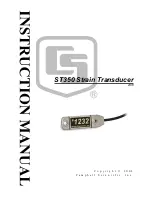
16 Installation
80%
100%
120%
140%
0%
20%
40%
60%
80%
1.0 1.5 2.0 2.5 3.0 3.5 4.0
Crest Factor
M
a
x
im
u
m
A
c
c
ur
a
te
C
T
C
ur
rent
(P
e
rc
ent
o
f R
a
te
d
C
ur
rent
)
Figure 8: Maximum CT Current vs. Crest Factor
You may not know the crest factor for your load. In this case, it’s generally safe to assume the
crest factor will fall in the 1.4 to 2.5 range and select CTs with a rated current roughly 150% of
the expected RMS current. So if you expect to be measuring currents up to 30 amps, select a 50
amp CT.
Connecting Current Transformers
●
Use only UL recognized current transformers (CTs) with built-in burden resistors that generate
0.33333 Vac (333.33 millivolts AC) at rated current. See
for
the maximum input current ratings.
●
Do not
use ratio (current output) CTs such as 1 amp or 5 amp output CTs: they will
destroy
the meter and present a shock hazard! These are commonly labelled with a ratio like 100:5.
●
Find the arrow or label “THIS SIDE TOWARD SOURCE” on the CT and face toward the
current source: generally the utility meter or the circuit breaker for branch circuits. If CTs are
mounted backwards or with their white and black wires reversed the measured power will be
negative. The diagnostic LEDs indicates negative power with flashing red LEDs.
●
Be careful to match up the current transformers to the voltage phases being measured. Make
sure the
Ø
A CT
is installed on the same conductor phase that is connected to
Ø
A
voltage
input, and the same for phases B and C. Use the supplied colored labels or tape to identify
the wires.
●
To prevent magnetic interference, the CTs on different phases should be separated by 1 inch
(25 mm). The line voltage conductors for each phase should be separated by at least 1 inch
(25 mm) from each other and from neutral.
●
For best accuracy, the CT opening should not be much larger than the conductor. If the CT
opening is much larger, position the conductor in the center of the CT opening.
●
Because CT signals are susceptible to interference, we recommend keeping the CT wires
short and cutting off any excess length. It is generally better to install the meter near the line
voltage conductors instead of extending the CT wires. However, you may extend the CT wires
by 300 feet (100 m) or more by using shielded twisted-pair cable and by running the CT wires
away from high current and line voltage conductors.
●
OPTIONAL: if you see spurious readings on unused phases, jumper the unused CT inputs.
To install CTs, pass each conductor to be measured through a CT and connect the CT to the
meter, as described below.
Always remove power before disconnecting any live wires.
Put
the line conductors through the CTs as shown in the section
Electrical Service Types (p. 8)
You may measure generated power by treating the generator as the source.
















































